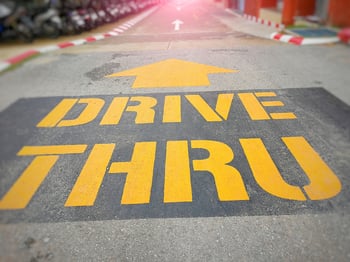Drive-thrus have become more and more popular, as customers seek convenience and speed.
But the increasing popularity of drive-thru service, paired with persistent labor shortages, has caused wait times to increase.

Call it the eternal paradox of the drive-thru: The more successful it is, the harder it becomes to be successful. Let’s look at how some top quick-service brands are increasing their speed of service and keeping guests satisfied.
Optimize the drive-thru ordering process.
One factor slowing drive-thru speed is customer confusion or indecision. Analyze your drive-thru environment to identify ways to help them order more quickly.
- Are there menuboards visible well in advance of the ordering point?
- Can you place QR codes in strategic spots, so people farther back in line can access the menu?
- Are you regularly testing new menuboard designs and configurations to see how that affects order amounts and drive-thru speed?
- Can you streamline the menu to simplify the ordering and food-prep processes?
- Do you have an order confirmation screen? (73% of drive-thru customers said this is “somewhat” or “most important” to their experience)
Ditch the dining room.
First, the quick-service dining rooms closed because of COVID. Then, they closed because there weren’t enough employees to run both the counter and the drive-thru. Now, in the interest of speeding service and cutting staff numbers, many operators are opting not to build them at all. Brands testing drive-thru-only models include Caribou Coffee, Starbucks, Tim Hortons, Portillo’s, and Schlotzsky’s.
Taco Bell may be the most prominent example. Its new Defy prototype made headlines for its unusual two-story design: a drive-thru with four lanes (for mobile, delivery and traditional ordering) passes under an elevated kitchen, which sends down customer orders in special lifts. The goal of this prototype is to reduce drive-thru time to two minutes or less, Taco Bell says.
Equip your staff for success.
Some quick-service restaurants are offering more training and speed-based incentives. But when your team is short-staffed and deep in the weeds, there’s no incentive that can magically make drive-thru service faster. One thing that can: foodservice equipment that can be operated hands-free.
- High-performance blenders timers with automatic shutoff or programmable, one-touch blending
- The powerful MixStation™ Heavy Duty Drink Mixer features a simple start/stop switch with optional foot pedal.
- The SmartServe™ Blend in Cup has programmable buttons, rinses itself and offers hands-free blending. Operators can perform other tasks or engage with customers while serving more than one drink per minute.
Remember: Satisfaction beats speed.
According to a recent study from FoodserviceResults, guests say they’re willing to spend a maximum of 13 minutes getting their drive-thru order. The good news: The average actual wait time for American quick-service restaurants in 2022 is 6 minutes and 13 seconds. Not too bad! Of course, that’s only an average; many restaurants see much longer waits.
Chicken chain Chick-fil-A has the slowest average drive-thru speed of service of the top 10 chains, the QSR study found: 8 minutes and 29 seconds (mainly owing to the number of vehicles in line). Nevertheless, Chick-fil-A consistently scores the highest in drive-thru customer satisfaction. How?
In a word, trust, says Khalilah Cooper, Chick-fil-A’s senior director of service and hospitality. Even when the drive-thru is packed, customers are willing to trust that it’s worth it: “I have to trust that this experience is going to be a good one for me to get into this line,” Cooper explains. When they receive smiling service and great food, that implicit promise is satisfied. Of all major quick-service chains, Chick-fil-A has, by far, the highest average number of cars waiting in the drive-thru (5.45). The wait might be longer, but they keep coming back.
Discover Hamilton Beach Commercial’s full line of commercial foodservice equipment for quick-service restaurants.


